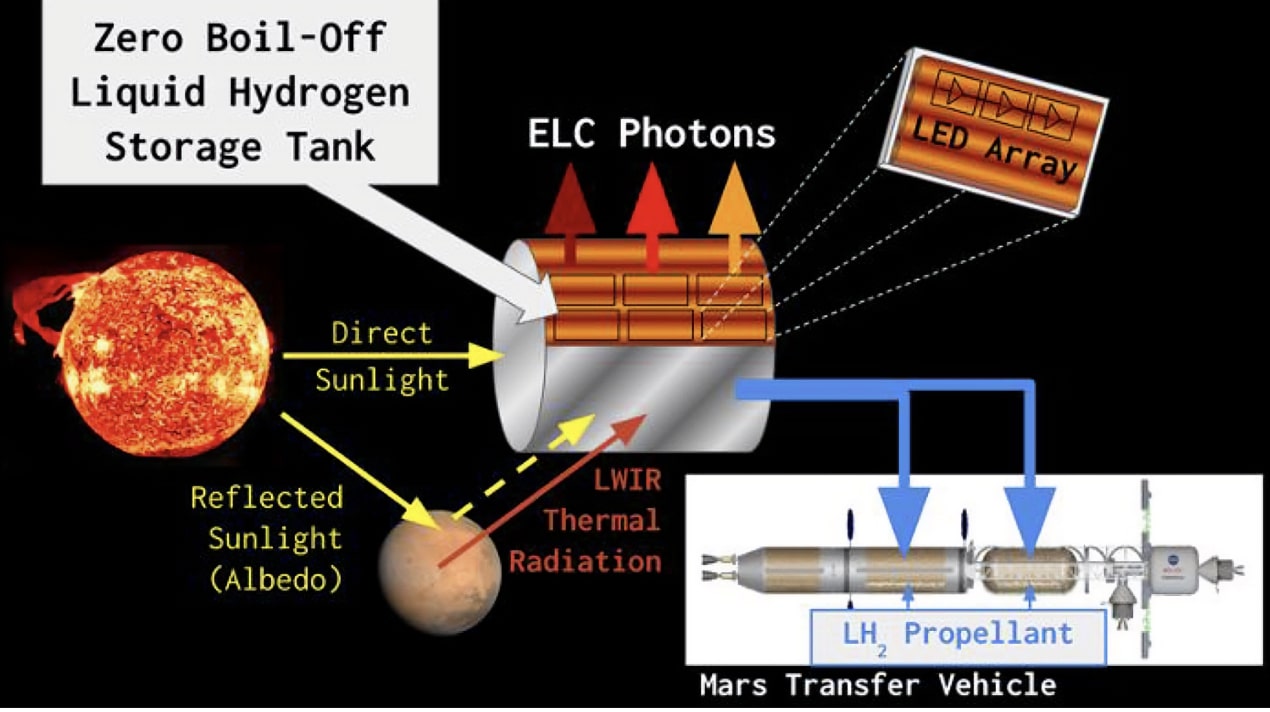One crucial area to enable trips to Mars is the long-duration storage of cryogenic propellants in various space environments. Relevant propellants include liquid Hydrogen (LH2) for high specific impulse Nuclear Thermal Propulsion (NTP) which can be deployed in strategic locations in advance of a mission. Such LH2 storage tanks could be used to refill a crewed Mars Transfer Vehicle (MTV) to send and bring astronauts home quickly, safely, and cost-effectively.
NASA NIAC study UCLA researchers propose a breakthrough mission concept: a cryogenic liquid storage depot capable of storing LH2 with ZBO even in the severe and fluctuating thermal environment of LEO. The innovative storage depot mission employs thin, lightweight, all-solid-state panels attached to the tank’s deep-space-facing surfaces that utilize a long-understood but as-yet-unrealized cooling technology known as Electro-Luminescent Cooling (ELC) to reject heat from cold solid surfaces as non-equilibrium thermal radiation with orders of magnitude more power density than Planck’s Law permits for equilibrium thermal radiation. Such a depot and tank would drastically lower the cost and complexity of propulsion systems for crewed Mars missions and other deep space exploration by allowing spacecraft to refill propellant tanks after reaching orbit rather than launching on the much larger rocket required to lift the spacecraft in a single-use stage. To achieve ZBO, a storage spacecraft must keep the storage tank’s temperature below the boiling point of the cryogen (e.g., ≈20 K for liquid H2). Achieving this in LEO-like thermal environments requires both excellent reflectivity toward sunlight and thermal radiation from the Earth and other nearby bodies as well as a power-efficient cooling mechanism to remove what little heat inevitably does leak in, a pair of conditions ideally suited to the the ELC panel concept that enables our mission. By enabling ZBO LH2 storage in LEO, the mission will enable cost-effective, and flexible crewed exploration of Mars. The mission will also demonstrate capabilities with ancillary benefits to cryogenic storage in terrestrial applications and solid-state cooling technologies more generally.

Brian Wang is a Futurist Thought Leader and a popular Science blogger with 1 million readers per month. His blog Nextbigfuture.com is ranked #1 Science News Blog. It covers many disruptive technology and trends including Space, Robotics, Artificial Intelligence, Medicine, Anti-aging Biotechnology, and Nanotechnology.
Known for identifying cutting edge technologies, he is currently a Co-Founder of a startup and fundraiser for high potential early-stage companies. He is the Head of Research for Allocations for deep technology investments and an Angel Investor at Space Angels.
A frequent speaker at corporations, he has been a TEDx speaker, a Singularity University speaker and guest at numerous interviews for radio and podcasts. He is open to public speaking and advising engagements.


NASA already has a nifty licensable patent for a ‘Cryogenic Flux Capacitor’ which uses aerogels to store cryogenic fluids (H2, O2, etc) in a “molecular surface-adsorbed state” at near liquid densities to avoid boil-off while allowing release to gas on demand via resistive heating.
Another solution to boil off: store your LOX-LH as water and break the water molecules apart with electrolysis using solar power or an electric generator powered by a nuclear reactor
Not really a solution to the refrigeration problem, given the power consumption necessary for doing that would be far greater than for just running a conventional cryo-cooler.
But there is something to be said for launching it as water in the first place, the convenience might be worth doing the electrolysis and liquification in orbit.
Likewise, when using methane /O2 for lunar work, send charcoal i.e. carbon, from each to lunar orbit. Send some of that to lunar surface, while bringing up water. Then run steam reformation over the carbon, producing CH4 and O2. Far cheaper to move charcoal and water, then make it for local consumption i.e. refueling rockets, then it is to either ship methane from earth or send CO2 and use the Sabatier reaction.
Though the later is what is needed on Mars.
Unlike the water into LH2 and LOX, charcoal and water wouldn’t produce a stoichiometric ratio. You’d need excess hydrogen to carry enough oxygen. I suppose hydrogen is pretty light, though. You’d probably have some weight savings doing it that way.
But if you’re launching methane and LOX into orbit with a rocket that burns methane and LOX, it’s probably not worth it, because your tanker is much simpler with just larger tanks, and neither is a deep cryogenic like the hydrogen.
“orders of magnitude more power density than Planck’s Law permits for equilibrium thermal radiation.”
Given that, at LH2 temperature, thermal radiation is about 34,000 times less than at room temperature, that doesn’t necessarily imply a lot of power density, I suppose.
But still, it’s my understanding that ELC is barely theoretically possible, and there’s some dispute over whether or not it’s actually been demonstrated in the lab at all.
This continues NASA’s self-destructive preference for approaches that would advance the bleeding edge of technology, over proven tech that just… works.
To make this work, we need BOTH economical and bleeding edge.
Use the economical such as Starship to get lunar base started but then move to bleeding edge for side issues as well as working towards lowering costs.
Let’s see if I recap this correctly:
Problem: liquid hydrogen and oxygen are cryogens. They tend to ‘boil off’ even in space, well protected from Sol’s heating.
Solution: Pull out the magic wand (electro-fluorescent cooling), and wäve it about enthusiastically.
Voilá. Problem solved.
Rah-Rahs: Now we can go to Mars, to the Kuiper Belt objects. We’ve solved the key problem, beaten ol’ Planck’s 19th century physics limits. Yay. Invest! We need the mun.
⋅-⋅-⋅ Just saying, ⋅-⋅-⋅
⋅-=≡ GoatGuy ✓ ≡=-⋅